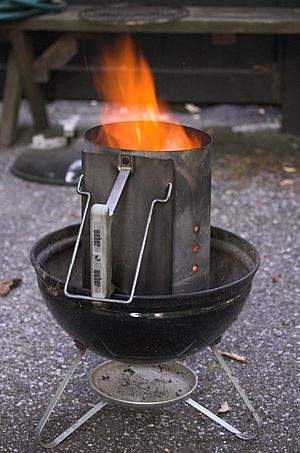Chimney starter facts for kids
A chimney starter is a cool tool that helps you light charcoal quickly and easily for your barbecue or grill. Think of it as a metal tube or cylinder with a special grate inside. This grate holds the charcoal, and there are holes at the bottom to let air flow through.
Some similar tools are called "lighting cones." These are shaped like cones and are placed over a grill's grate to help charcoal catch fire. Chimney starters are usually made of steel and are about 6 to 8 inches (15–20 cm) wide and 8 to 12 inches (20–30 cm) tall. They often have insulated handles so you can pick them up safely when they're hot.
Contents
How Chimney Starters Work
Chimney starters are super effective because they create a strong "draft." Imagine a mini-tornado of air rushing up through the charcoal. This draft brings lots of oxygen to the coals, which helps them burn hotter and faster.
When you use a chimney starter, you put some kindling (like newspaper) at the bottom, under the grate. Then, you pile your charcoal lumps or briquettes on top of the grate. When you light the kindling, it sets the charcoal on fire.
Here's the clever part:
- The coals are packed closely together, so the heat from one burning coal quickly spreads to its neighbors. This is called thermal radiation.
- Hot air rises, and as it does, it heats the coals higher up in the stack. This is called convection.
Because of this design, all the charcoal gets hot and ready to use much faster than if you just spread it out on a grill. Studies have even shown that using a similar tool can cut the time it takes to light charcoal in half and reduce harmful carbon monoxide gas. Plus, the chimney protects the charcoal from wind and helps direct the smoke away.
Once all your charcoal is glowing red at the bottom and covered with a light gray ash on top, it's ready! You just lift the chimney by its handle and carefully dump the hot charcoal into your grill. If you have some burning charcoal left in the chimney, you can add new charcoal on top, and it will light up quickly.
A Look Back: History of Chimney Starters
People have been trying to find better ways to light fires for a long time!
Early Designs
- In 1910, someone in Britain designed a metal portable stove that could also be used as a "Fire Lighter." It used paper under a cone-shaped grate, with wood or coal on top.
- By 1917, a design very similar to today's chimney starter appeared. It was a metal cylinder with a raised grate and air holes. However, it was called a "camp stove" back then, not a fire starter.
Homemade Versions
In the 1950s, people often made their own "kindle cans." They would use old metal cans from coffee, fruit juice, or even motor oil. They'd punch holes in the cans for air, but these homemade versions usually didn't have a grate inside or a handle. So, you'd need tongs to move them around!
Modern Patents
Over the years, many different types of chimney starters have been patented. A Patent drawing from 1965 shows a design very much like the ones we use today. These patents helped improve the design, making them safer and more efficient.
Cooking with a Chimney Starter
Did you know you can even cook directly over a chimney starter? If you add an extra grate on top, you can use the intense heat from the burning charcoal below. This is perfect for searing foods quickly, like steaks or burgers, giving them a delicious crispy outside.
Images for kids



